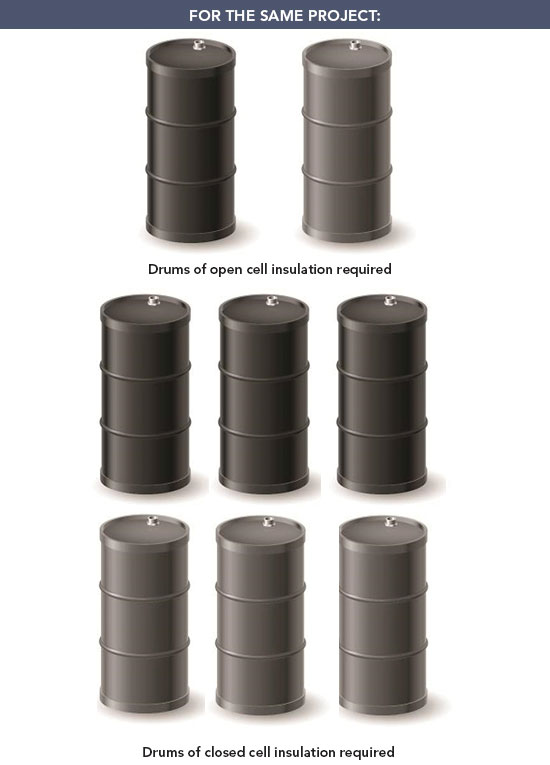Open Cell Spray Foam Insulation in Commercial Buildings
The significance of the air barrier qualities of spray foam insulation has been observed and studied by independent research organizations. The National Research Council of Canada (NRCC) in particular has produced a Wall Energy Rating factor that compared the performance delivered during controlled testing versus the expected performance based on nominal R-values. In these tests, spray foam consistently performed at more than 90 percent of nominal R-value whereas air-permeable, fibrous insulation performed in the range of 35 percent to 65 percent of nominal R-value even with a plastic vapor barrier in place. The study concludes that, without a proper air barrier, insulation alone cannot deliver optimal energy efficiency and comfort. This is why air barriers are now a mandatory provision of energy codes and industry standards such as ASHRAE 90.1. Further, the NRCC study found that low-density open cell foam was the most effective air barrier material out of the insulation and air barrier alternatives studied.
It should be noted that while open cell insulation is an effective air sealant, it does allow water vapor to diffuse through it. Hence, in cold climates (climate zones Marine 4 and higher), a warm side vapor retarder (e.g. vapor retardant paint) will be needed to control vapor diffusion in an exterior wall or unvented attic assembly.
Overall, the use of spray foam insulation, then, goes beyond just R-values and truly addresses a comprehensive way to optimize energy efficiency, making the thermal performance arguments for using open cell spray foam insulation very compelling. It has the highest expansion (100 to 1) of any spray foam insulation product, giving it the ability to flow into and seal cracks and gaps. It has the widest application envelope (temperature and humidity), giving it maximum flexibility to mesh with tight construction schedules and deadlines. It doesn't trap moisture, allowing it instead to escape and thereby dry adjacent materials.
Cost Effectiveness of Open Cell Insulation
Achieving the multiple properties of thermal insulation and air sealing in a single step obviously saves labor and material costs compared to other multi-component assemblies. This is usually seen as the first and most obvious contributor to the cost effectiveness of open cell spray insulation. Some architects and designers working in cold climates (all of Canada and Zones 5 to 8 in the U.S.) may still select medium-density foam thinking that they can also get an integral vapor barrier in the one product. However, the cost difference between the higher-density foam is much greater than the cost of using a simple vapor retarder. There may be other reasons to consider medium-density foam, but the cost effectiveness changes when the density of the foam changes.

Image courtesy of ICYNENE, Inc.
Part of the cost-effectiveness of open cell low-density spray foam insulation is directly tied to its greater yield in comparison to medium-density foam.
From an installation standpoint, open cell low-density foam can be applied in a single continuous application without regard for depth. This is in contrast to most closed cell medium-density insulation that is limited to 2-inch lifts to allow setting and curing. Hence, the open cell installation is quicker and therefore reduces labor cost.
Perhaps one of the biggest contributors to the cost effectiveness of open cell, low-density insulation is its inherently high yield. In this context, yield is a measure of the coverage capability of foam. Low-density foam has a yield that is three to four times higher (100:1 versus 30:1) than medium-density foam. In practical terms, that means that one drum each of the two ingredients needed to create low-density foam covers the same portions of a building that would require three drums each of ingredients for medium-density spray foam. This simple math directly contributes to making open cell low-density foam more cost effective than other alternatives.











